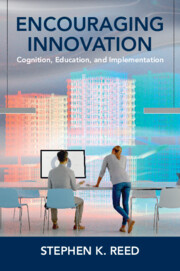Book contents
- Encouraging Innovation
- Encouraging Innovation
- Copyright page
- Dedication
- Contents
- Preface
- Part I Cognition
- Chapter 1 Reasoning
- Chapter 2 Problem Solving
- Chapter 3 Creativity
- Chapter 4 Group Decision Making
- Chapter 5 Collaborative Problem Solving
- Part II Education
- Part III Implementation
- References
- Name Index
- Subject Index
Chapter 1 - Reasoning
from Part I - Cognition
Published online by Cambridge University Press: 17 August 2023
- Encouraging Innovation
- Encouraging Innovation
- Copyright page
- Dedication
- Contents
- Preface
- Part I Cognition
- Chapter 1 Reasoning
- Chapter 2 Problem Solving
- Chapter 3 Creativity
- Chapter 4 Group Decision Making
- Chapter 5 Collaborative Problem Solving
- Part II Education
- Part III Implementation
- References
- Name Index
- Subject Index
Summary
Chapter 1 begins with the distinction between reasoning from associations and reasoning from rules – a distinction that will resurface in subsequent chapters on creativity and innovation. The associative system is reproductive, automatic, and emphasizes similarity. The rule-based system is productive, deliberative, and emphasizes verification. Daniel Kahneman’s (2011) best-selling book Thinking Fast and Slow introduced readers to how associative and rule-based reasoning influence the speed of responses. The third section on biases in reasoning describes Kahneman’s classic research with Amos Tversky on how the use of heuristics such as availability and representativeness influence frequency estimates. The final section discusses monitoring reasoning in which people use knowledge to improve their thinking skills. Monitoring reasoning is a metacognitive skill that controls the selection, evaluation, revision, and abandonment of cognitive tasks, goals, and strategies.
- Type
- Chapter
- Information
- Encouraging InnovationCognition, Education, and Implementation, pp. 3 - 15Publisher: Cambridge University PressPrint publication year: 2023

